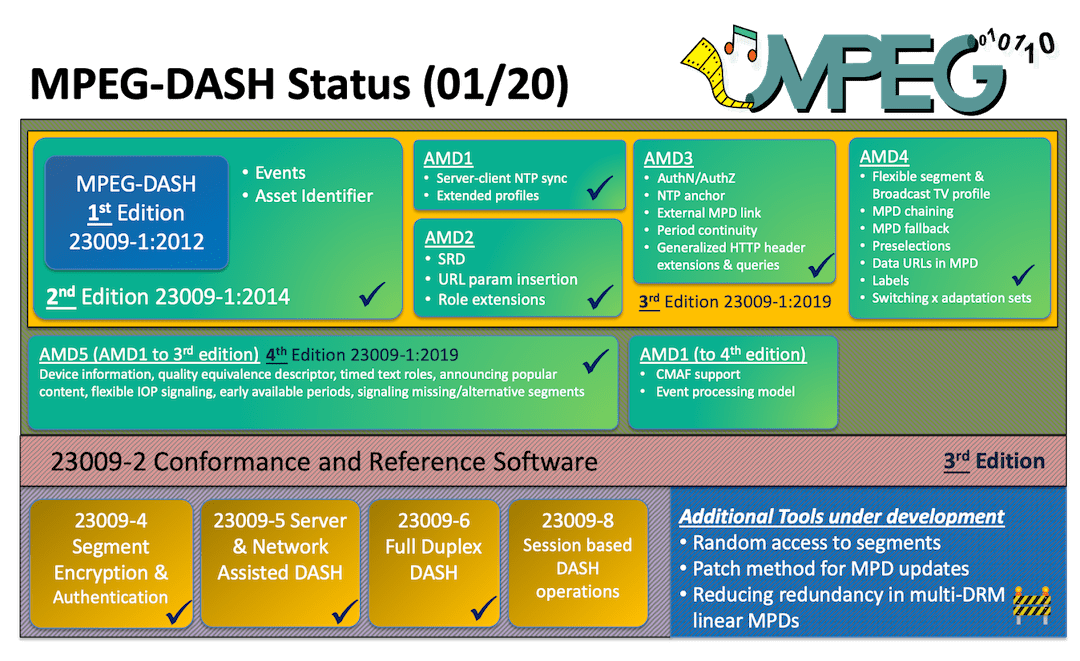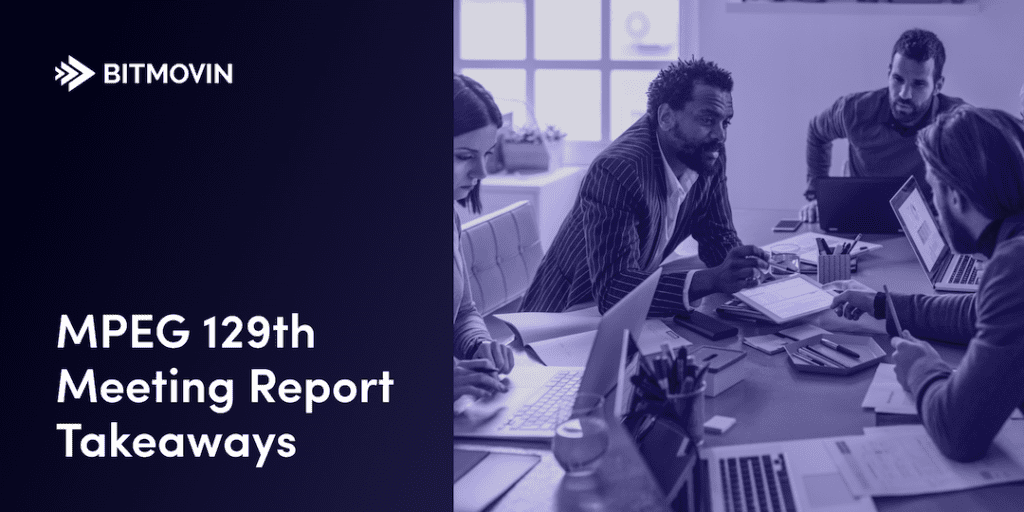About MPEG Meeting
“Shaping the Future of Video” is not just a catchy slogan that we like to throw around, rather it’s Bitmovin’s company vision. Not only do we keep a close eye on the industry trends, but we’re actively taking part in standardization activities to improve the quality of video technologies. I have been a member and attendant of the Moving Pictures Experts Group for 15+ years and have been documenting the progress since early 2010.
The goal of each meeting is to provide a working group and open discussion amongst industry experts to yield the best video standards. At each meeting different technical submissions are reviewed by the committee and work is assigned to members for the next meeting. This allows MPEG to attract the best expertise in its fields and to produce the technically most advanced standards. Our first meeting of the year was attended by over 500 video experts from 25 different countries

MPEG fosters Cloud-based Media Processing across Multiple Platforms
We open 2020 with a continuation of our work in 2019, primarily, focusing on the constant improvement of the DASH-MPEG standard and increased CMAF support. However, the majority of our work for this opening meeting was based on the increased need for cloud-based standards and applications. As such, Network-Based Media Processing progression was prioritized. A full list of the main topics can be found below:
- Network-Based Media Processing (NBMP) promoted to the final stage of review
- Publication of the Technical Report on Architectures for Immersive Media
- WG11 receives answers to the joint call for proposals on genomic annotations in conjunction with ISO TC 276/WG 5
- MPEG promotes Amendment of Open Font Format to the final stage of review
- WG11 progresses Baseline Profile for MPEG-H 3D Audio
- Conformance and Reference Software for Compact Descriptors for Video Analysis promoted to the final stage
Other Important Activities at the 129th MPEG meeting: (i) a scene description for MPEG media, (ii) the integration of Video-based Point Cloud Compression (V-PCC) and Immersive Video (MIV), (iii) Video Coding for Machines (VCM), and (iv) a draft call for proposals for MPEG-I Audio among others.
The corresponding press release of the 129th MPEG meeting can be found here: https://mpeg.chiariglione.org/meetings/129. This report focused on network-based media processing (NBMP) as well as an update about adaptive streaming formats (i.e., DASH and CMAF).
Network-Based Media Processing (NBMP)
At its 129th meeting, MPEG promoted ISO/IEC 23090-8, Network-Based Media Processing (NBMP), to Final Draft International Standard (FDIS). The FDIS stage is the final vote before a document is officially adopted as an International Standard (IS). During the FDIS vote, publications and national bodies are only allowed to place a Yes/No vote and are no longer able to make any technical changes. However, project editors are able to fix typos and make other necessary editorial improvements.
What is NBMP? The NBMP standard defines a framework that allows content and service providers to describe, deploy, and control media processing for their content in the cloud by using libraries of pre-built 3rd party functions. The framework includes an abstraction layer to be deployed on top of existing commercial cloud platforms and is designed to be able to be integrated with 5G core and edge computing. The NBMP workflow manager is another essential part of the framework enabling the composition of multiple media processing tasks to process incoming media and metadata from a media source and to produce processed media streams and metadata that are ready for distribution to media sinks.
Why NBMP? With the increasing complexity and sophistication of media services and the incurred media processing, offloading complex media processing operations to the cloud/network is becoming critically important in order to keep receiver hardware simple and power consumption low.
DASH and CMAF
The 4th edition of DASH has already been published and is available as ISO/IEC 23009-1:2019. Similar to previous iterations, MPEG’s goal was to make the newest edition of DASH publicly available for free, with the goal of industry-wide adoption and adaptation. During the most recent MPEG meeting, we worked towards implementing the first amendment which will include additional (i) CMAF support and (ii) event processing models with minor updates; these amendments are currently in draft and will be finalized at the 130th MPEG meeting in Alpbach, Austria. An overview of all DASH standards and updates are depicted in the figure below:

ISO/IEC 23009-8 or “session-based DASH operations” is the newest variation of MPEG-DASH. The goal of this part of DASH is to allow customization during certain times of a DASH session while maintaining the underlying media presentation description (MPD) for all other sessions. Thus, MPDs should be cacheable within content distribution networks (CDNs) while additional information should be customizable on a per session basis within a newly added session-based description (SBD). It is understood that the SBD should have an efficient representation to avoid file size issues and it should not duplicate information typically found in the MPD.
The 2nd edition of the CMAF standard (ISO/IEC 23000-19) will be available soon (currently under FDIS ballot) and MPEG is currently reviewing additional tools in the so-called ‘technologies under considerations’ document. Therefore, amendments were drafted for additional HEVC media profiles and exploration activities on the storage and archiving of CMAF contents.
The next meeting will bring MPEG back to Austria (for the 4th time) and will be hosted in Alpbach, Tyrol. For more information about the upcoming 130th MPEG meeting click here.
Click here for more information about MPEG meetings and their developments
Check out the following links for other great reads!
A little lost about the formats and standards described above? Check out some other great educational content to learn more!
- Bitmovin’s Video Developer Network (No Sign-up Required!)
- [E-Book] Ultimate Guide to Container Formats
To see these formats tested against existing Per-Title Encoding products, by industry expert Jan Ozer, Check out the following Whitepaper: Choosing the Best Per-Title Encoding Technology




